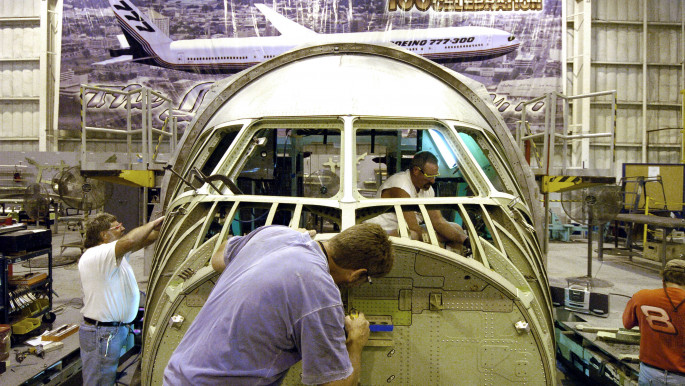
What causes planes to crash or go missing?
What causes planes to crash or go missing?
According to statistics, you are more likely be killed by falling out of bed than in an air accident. What, then, are the causes when things do go wrong?
4 min read
Rescuers secure US Airways flight 1549 which crashed into New York's Hudson River, 2009 [Getty]
According to some statistics, the likelihood of a plane crashing ranges from as unlikely as one in 5.4 million to one in 11 million. This puts the likelihood of death from an air disaster behind terrorism, food poisioning and even falling out of bed.
So what are the unlikely causes of when things do go wrong?
Human vs mechanical error
According to Boeing, one of the world's largest aircraft manafacturers, mechanical errors accounted for around 80 percent of accidents in the early days of flight, with human error responsible for the remaining 20 percent. By the early 2000s, however, improved technology meant that this trend had reversed, with accidents related to aviation equipment accounting for only 20 percent of incidents.
Today, more than half of plane crashes are caused by errors related to pilots, air traffic control crews and cabin staff.
This is all the more understandable when the potential variables for disaster are considered. While many accidents have occurred due to misjudgements about weather and initially minor mechanical problems, there are other factors that can affect a pilot's performance during flight.
In 1976, a South African Airways plane crashed after the pilot suffered a heart attack, and a flight from Tokyo in 1987 ended in disaster when a pilot suffering from mental issues put the plane's engines into reverse mid-flight.
Crashes have also been caused by pilot fatigue or the working cultures of the airlines. When a Korean Air cargo plane crashed in 1999 in England, an investigation into the causes revealed that it may have been due to a culture of deference within the flight crew's heirarchy of command.
 |
|
| Improvements to technology have increased flight safety [Getty] |
A misjudgment by the pilot was not corrected by his first officer, likely out of respect for his experience, and as a result the plane crashed and killed all four crew members.
Adding to the list of human errors are simple but costly mistakes. A shocking example in 1972 saw Eastern Airline flight 401 crash into the Florida Everglades, killing 101 passengers and crew.
The crash was the result of all three members of the flight's crew becoming engrossed in trying to figure out why a single indicator light relating to the plane's landing gear was not working.
As the trio racked racked their brains over the issue, they forgot that the plane's auopilot was on the wrong setting, only realising their mistake too late.
While billions of dollars in technological improvements have reduced the chances of accidents, humans will always be subject to factors that are beyond the scope of improved company policies and procedures.
Adding to the list of human errors are simple but costly mistakes. A shocking example in 1972 saw Eastern Airline flight 401 crash into the Florida Everglades, killing 101 passengers and crew.
The crash was the result of all three members of the flight's crew becoming engrossed in trying to figure out why a single indicator light relating to the plane's landing gear was not working.
As the trio racked racked their brains over the issue, they forgot that the plane's auopilot was on the wrong setting, only realising their mistake too late.
While billions of dollars in technological improvements have reduced the chances of accidents, humans will always be subject to factors that are beyond the scope of improved company policies and procedures.
Weather
According to the National Transportation Safety Board in the United States, weather is a primary factor in 23 percent of all aviation accidents.Bad weather is often cited as an initial reason in aviation incidents, however closer investigation often sometimes reveals other key contributing factors.
An instance of this may be found in the crash of AirAsia flight QZ8501 in 2014, when the flight from Indonesia to Singapore encountered heavy thunderclouds on its route.
 |
|
| Indonesian rescue teams recover the wreckage of AirAsia flight QZ8501 [AFP] |
This was originally proposed as the cause of the accident which killed all 162 people on board, however it was later found that a technical error, coupled with a failure in the flight crew's response, were more instrumental in the disaster.
Improvements in technology have also ensured that aeroplanes are able to withstand lightning strikes, with the last commercial air crash caused by lightning way back in 1963.
Cause for concern?
Despite disasters such as the disappearance of Malaysia Airlines flight MH370 in 2014, and the shooting down of MH17 in the same year grabbing headlines in recent years, travelling by air remains one of the safest ways to travel.
"Even if you look back over the past two to three years, the amount of aircraft being produced has increased," Kingston University aviation expert Dr Neil Padhra told The New Arab.
"Global air traffic is increasing, meaning that the incidences of things going wrong is simply because there are more flights taking place."
Improvements to technology and lessons learned from past crashes have all contributed to the safety of commercial airliners today, with the odds of being involved in a plane crash markedly less than that of road traffic accidents.
Join the conversation. Tweet to us: @the_newarab



